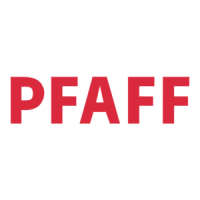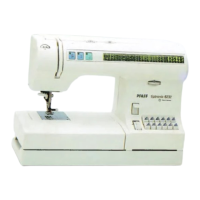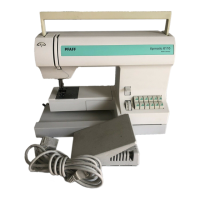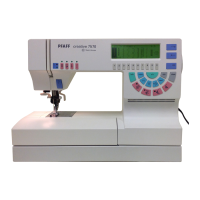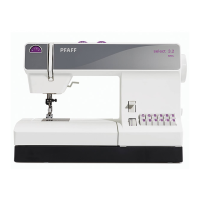Do you have a question about the Pfaff tiptronic 2040 and is the answer not in the manual?
Safety guidelines specific to Australia regarding cord damage, supervision, and unattended use.
Basic safety precautions for household use of electric appliances, including shock and burn risks.
Notes on safety for domestic sewing machines in accordance with EN/IEC standards.
Overview of the sewing machine's modern design and ease of use.
Instructions for using the carrying case and opening the top cover.
Connecting the power lead, foot control, master switch, and voltage selection.
Locating and arranging the machine's accessories.
Removing the work support and preparing for bobbin winding.
Instructions for winding bobbins from spool pins and the second spool holder.
Step-by-step guide for threading the sewing machine.
Removing and inserting the bobbin case.
Adjusting needle and bobbin thread tension for optimal seams.
Step-by-step guide for manually threading the sewing machine needle.
Instructions for using the automatic needle threader.
Using the presser foot lifter and thread cutter.
Adjusting the needle thread tension dial for sewing.
Procedure for removing and inserting sewing machine needles.
Instructions for threading the machine with a twin needle.
Overview and benefits of the Integrated Dual Feed system.
How to lower the feed dog for specific sewing techniques.
Adjusting screen contrast and understanding the bobbin thread monitor.
Methods for selecting desired sewing programs using the machine.
Adjusting the size of patterns using control keys.
Modifying stitch width and needle position for straight stitches.
Altering the width of patterns and length of stitches.
Adjusting the length of decorative patterns and stitch density.
Adjusting the balance for optimum embroidery stitches.
Functions of the reverse sewing and info keys.
Using keys for tie-off, needle position, slow sewing, and pattern mirroring.
Considerations for using twin needles with stitch patterns.
Understanding how different stitch patterns are formed.
Possibility of storing pattern and word sequences in machine memories.
Using keys for pattern sequence operations and memory management.
Changing pattern length/width and using the 'pattern beginning' function.
Description of straight, basting, and top stitching.
Explanation of blind stitch and elastic blind stitch.
Details on zigzag, stretch triple zigzag, and stretch straight stitches.
Description of elastic, honeycomb, and various overlock stitches.
Procedures for sewing buttons and automatic darning.
Techniques for lace work, gathering, and seam finishes.
Description of fancy elastic, light-knit mending, and quilting stitches.
Darning with elastic stitch and sewing-on patches.
Methods for creating smocking effects.
Procedure for roll hemming.
Instructions for sewing zippers, including centered and trouser zippers.
Shell edging technique and use of the pattern mirror key.
Inserting the buttonhole guide and foot.
Overview of available buttonhole types.
Choosing specific buttonhole types like linen, stretch, or keyhole.
Steps for sewing a fully automatic buttonhole.
Procedure for sewing semi-automatic buttonholes.
How the machine completes the buttonhole automatically.
Steps for sewing buttonholes manually.
Using gimp thread for durable and professional-looking buttonholes.
Advice for sewing buttonholes on challenging fabrics and reinforcement.
Introduction to standard presser feet and accessory table.
Details on standard presser feet 0 through 3.
Details on standard presser feet 4 through 7.
Description of special accessories like edge guides and bulb removers.
Overview of accessory feet for appliqué, pintucks, felling, and shirring.
Accessory feet for quilting, patchwork, and narrow edge work.
Instructions for using the felling and appliqué feet.
How to use the pintuck foot with guide for creating pintucks.
Techniques for using the cording and shirring feet.
Instructions for using the knit edge and ruffler feet.
Using the 1/4 inch foot for quilting and patchwork.
Using the free-motion quilt foot and bias tape binder.
Using pintuck foot with guide and non-stick foot for leather.
Techniques for using the 7/9 hole and braiding feet.
Creating perfect embroidered circles using the guide.
Techniques for using fringe and narrow edge feet.
General notes and recommendations for embroidery work.
How to create borders by combining embroidery programs.
Using a twin needle for additional embroidery effects.
Techniques for monogramming terry cloth and using zigzag stitch.
Method for creating striking embroidery motifs using free motion.
How to alter pattern width and length using control keys.
Explanation of tapering and its effects on zigzag seams.
Introduction to automatic tapering for corners and patterns.
Procedures for manual tapering of regular and irregular patterns.
Creating floral embroidery and blossom designs.
Step-by-step instructions for automatic tapering.
Continuing tapering and creating decorative buttonholes.
Procedure for creating beautiful appliqué designs.
Procedure for creating artistic bar and eyelet embroidery.
Overview of quilting as a technique and relevant stitches.
Steps for piecing quilt tops and free-motion quilting.
Overview of cross-stitch embroidery and sewing tips.
Procedure for creating eyelet embroidery.
Procedures for changing the needle plate and sewing lamp.
Instructions for cleaning and oiling the sewing machine.
Steps for removing and inserting the sewing lamp bulb.
Troubleshooting common problems like skipped stitches and thread breaks.
Technical details and contents included with the sewing machine.
A list identifying parts of the sewing machine by number.
| Type | Electronic |
|---|---|
| Maximum Stitch Width | 7 mm |
| Maximum Stitch Length | 5 mm |
| Display | LCD |
| Built-in Needle Threader | Yes |
| Free Arm | Yes |
| Presser Feet | 7 |
| USB Port | No |
| Built-in Designs | No |
| Machine Type | Sewing Machine |
| Embroidery Area | Not Applicable |
| Bobbin System | Drop-in |
